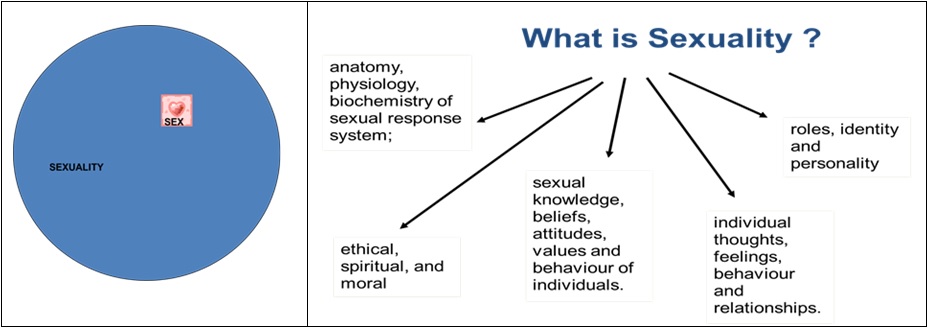(SEXUAL AND REPRODUCTIVE HEALTH FOR CHILDREN AND ADOLESCENTS WITH DISABILITIES)
INTRODUCTION
All disabled people have the same biological means and needs. Persons with disabilities are living longer nowadays and are choosing to wed or become sexually involved. Teaching them sexual awareness from the young age can help them elude many pitfalls later and also for their personal safety.
It is commonly said that children with disabilities are asexual, meaning they have no sexual capabilities or urges. Such a myth is highly dangerous for these children with disabilities and they are more prone to sexual abuse as well as developing inappropriate sexual behaviour.
They don’t understand sexuality and abuse. Hence, they are less able to recognize or report abusive situations and can easily manipulated by others. They also might think that such behaviour or helping for their daily needs like bathing, dressing and mobility is appropriate. So, the children and adolescents with disabilities have a genuine need to learn about sexuality.
WHEN TO START/START YOUNG
It is never too early to start sex education especially towards children with disabilities. The answer is “as early as possible”. Make it age appropriate by starting with explanations on how to take care of their hygiene.
You can explain to them in simple language on why and what you do to clean them up after diaper-soaks or bowel movements and also during a bath or shower. Then, make them aware that others aren’t allowed to do the same unless these people are specifically given permission to do so. This is critical when there are other caregivers involved such as maids, siblings or nursery staff.
Discuss what makes them uncomfortable and inform your child it is okay to say “No” or “I don’t like you touching me like that” and empower them to do so.
FACT
This article hopefully can give understandings about sexuality and personal safety. Goals of comprehensive sexuality education are to:
-
Provide information such as understanding the differences between sexuality and sex. Sex is a small part of sexuality.
-
Develop values (family, religion, cultural values).
-
Develop interpersonal skills.
-
Develop responsibility for their bodies and actions.
-
Know how and when to seek help.
Human sexuality encompasses:
-
Sexual knowledge
-
Beliefs, attitudes and values
-
Behavior. It deals with the anatomy, physiology and biochemistry of sexual response system. Sex is the act and a small part of sexuality.

Tips for talking about sexuality:
-
Break topics into smaller subtopics for easier understanding
-
Start with basics (ask them what they know)
-
Be concrete (use visual cues & give examples)
-
Be repetitive and cumulative
-
Modify for specific disabilities. Focus on individual not on disability
-
Be clear, use both medical and simple terms but emphasis the need to use the correct medical term
-
Comfortable with the topic, it is significant to convey positive message about sexuality to build self-esteem
-
Ability to respond effectively to inappropriate behaviour, give a non-emotional response
-
Be non-judgmental
-
Understand dynamics of child sexual abuse
GUIDE AGE-APPROPRIATE SEXUAL EDUCATION
The contents should be taught in a few sessions. Parents or care providers must consistently “teach” using every available teaching moment. Our attitudes must relate to our culture, ethnicity, personality, upbringing, family values, religion and past experiences. The outline of what have to be taught are as the followings:
|
|
3 – 9 years |
10 – 15 years |
16 years and above |
|
Body parts |
Difference between boys and girls. Naming body parts including private body parts using proper terminology and its function |
Life cycle changes |
Your body is your responsibility |
|
|
Public and private body parts |
Puberty changes – physical, mental & emotional |
Difference between sex & love |
|
|
How babies are made in simple terms when opportunities arise |
Details of how babies are made. Understand the concept of reproduction |
Responsibilities of sexual relationships & parenting |
|
|
Hygiene |
Hygiene & Masturbation |
Hygiene & Masturbation |
|
Public & private |
Safe & unsafe places |
Safe & unsafe places |
Behaviour, dressing & the way to look at people |
|
|
Behaviour – make adjustments when opportunity arise |
Behaviour, dressing & the way to look at people |
|
|
|
Conversation – correct it when opportunities arise |
Conversation – talk to people you trust |
Conversation with trusted people |
|
Feelings & emotions |
Basic skills in socialisation & communication |
Building and maintaining relationships with the same or the opposite gender |
Building and maintaining relationships with the same or the opposite gender |
|
|
Recognising and expressing emotions, making friends |
The way to look at & talk to people |
The way to look at & talk to people |
|
Relationship & touch |
Relationship boundaries |
Relationship boundaries between the same or the opposite genders |
Relationship boundaries between the same or the opposite genders |
|
|
Recognising different types of touch
|
Recognising different types of touch & saying “No” to inappropriate touch Everyone has a place & personal space |
Recognising different types of touch & saying “No” to inappropriate touch Everyone has a place & personal space |
|
|
Saying “No” to inappropriate touch |
Laws & consequences of inappropriately touching others |
Laws & consequences of inappropriately touching others |
|
Safety plans : |
Teach child about safety. Say “No” or Shout, Go & Tell |
Teach child about safety. Say “No” or Shout, Go & Tell |
Teach child about safety. Say “No” or Shout, Go & Tell |
|
|
NEVER keep a SECRET about TOUCHING issues |
||
| Last Reviewed | : | 8 October 2014 |
| Writer | : | Dr. Salimah bte. Othman |
| Translator | : | Dr. Salimah bte. Othman |
| Accreditor | : | Dr. Norharlina bte. Bahar |







